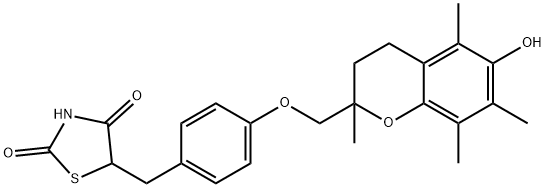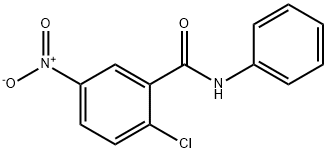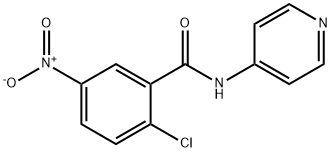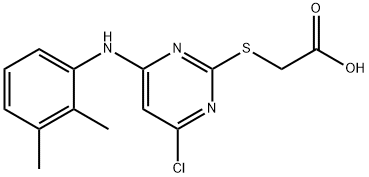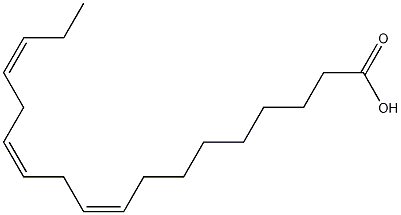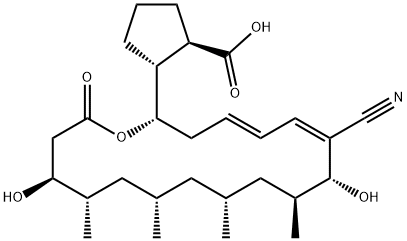CIGLITAZONE
Synonym(s):(±)-5-[4-(1-Methylcyclohexylmethoxy)benzyl]thiazolidine-2,4-dione, PPAR Agonist II, PPARγ Agonist I;(±)-5-[4-(1-Methylcyclohexylmethoxy)benzyl]thiazolidine-2,4-dione;Ciglitazone;Ciglitazone - CAS 74772-77-3 - Calbiochem
- CAS NO.:74772-77-3
- Empirical Formula: C18H23NO3S
- Molecular Weight: 333.45
- MDL number: MFCD00865499
- SAFETY DATA SHEET (SDS)
- Update Date: 2024-11-19 15:53:33
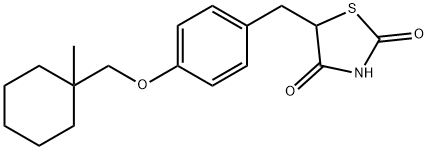
What is CIGLITAZONE?
Description
Ciglitazone (74772-77-3) is a PPARγ agonist (EC50=3 μM). Stimulates adipogenesis in human mesenchymal stem cells. Ciglitazone inhibits HUVEC differentiation and angiogenesis. Cell permeable.
Chemical properties
White Cyrstalline Solid
Originator
Ciglitazone, synthetized by Takeda and reported in 1982, was a result of screening of clofibrate analogues for hypolipidemic activity.
The Uses of CIGLITAZONE
Displays antihyperglycemic activity in genetically obese mice. It is a selective PPARg agonist
The Uses of CIGLITAZONE
Displays antihyperglycemic activity in genetically obese mice. It is a selective PPARg agonist.
The Uses of CIGLITAZONE
Ciglitizone has been used as a proliferator-activated receptor γ (PPARγ) agonist:
- to study its effects on cell proliferation in human melanocytes
- to study its effects on pigmentation and migration of human melanocytes
It also may be used to study its effects on cell cycle and apoptosis in monocytic cells.
What are the applications of Application
Ciglitazone is an inhibitor of HUVEC differentiation and angiogenesis that stimulates adipogenesis
Definition
ChEBI: An aromatic ether that consists of 1,3-thiazolidine-2,4-dione with position 5 substituted by a 4-[(1-methylcyclohexyl)methoxy]benzyl group. A selective PPARgamma agonist.
General Description
A potent thiazolinedione (TDZ) type anti-hyperglycemic agent and a selective PPARγ agonist (EC50 = 3 μM).
Biological Activity
Selective agonist at PPAR γ (peroxisome proliferator-activated receptor γ ). Activates PPAR γ with an EC 50 value of 3 μ M in vitro , and is at least 33-fold selective over PPAR α and δ . Antihyperglycemic in vivo .
Biochem/physiol Actions
Ciglitizone belongs to the class of thiazolidinediones and is a peroxisome proliferator-activated receptor γ (PPARγ) agonist. It exhibits anti-diabetic activity. Ciglitizone has the potential to treat tumor necrosis factor α (TNFα)-related apoptosis-inducing ligand (TRAIL)-refractory high-grade urothelial cancers.
Pharmacology
Ciglitazone reduced plasma triglycerides, hyperglycemia and hyperinsulinemia in several insulin resistant diabetic and nondiabetic rodent models after repeated oral dosing at doses of 100 – 300 mg/kg body weight, while having little or no effect in normal rodents or those with insulin deficient diabetes. In long-term animal studies lens cataracts occurred and ciglitazone development was discontinued.
storage
Room temperature
Mode of action
Ciglitizone is a thiazolidine-2,4-dione derivative. The mechanism of blood glucose lowering activity by thiazolidinedione derivatives has not been fully elucidated yet. Only minor or no effects are observed in normal animals or insulin sensitive diabetes models. In obese or hyperinsulinemic insulin resistant rodents thiazolidinediones lower insulin and triglyceride levels after treatment for 2 to 8 d. If hyperglycemia occurs, also the blood glucose concentration is reduced. Mechanistic in vitro studies with adipocytes have shown that the thiazolidinediones are ligands of the peroxisome proliferator activated receptor. Peroxisome proliferator activated receptors (PPARs) belong to the nuclear receptor superfamily of ligand-activated transcription factors. So far, three receptor subtypes have been identified: PPAR , PPAR , and PPAR . The PPARs are believed to play a physiological role in the regulation of lipid metabolism. The in vivo antihyperglycemic activity of thiazolidinediones strongly correlates with their potency as PPAR agonists in vitro.
References
1) Cantello et al. (1994) [[omega-(Heterocyclylamino)alkoxy]benzyl]-2,4-thiazolidinediones as potent antihyperglycemic agents; J. Med. Chem. 37 3977 2) Xin et al. (1999) Peroxisome proliferator-activated receptor gamma ligands are potent inhibitors of angiogenesis in vitro and in vivo; J. Biol. Chem. 274 9116
Properties of CIGLITAZONE
| Melting point: | 130-131°C |
| Boiling point: | 504.5±23.0 °C(Predicted) |
| Density | 1.189±0.06 g/cm3(Predicted) |
| storage temp. | Store at RT |
| solubility | Soluble in DMSO (up to 25 mg/ml) or in Ethanol (up to 25 mg/ml). |
| form | Tan solid |
| pka | 6.36±0.50(Predicted) |
| color | Tan |
| Stability: | Stable for 1 year from date of purchase as supplied. Solutions in DMSO or ethanol may be stored at -20°C for up to 3 months. |
Safety information for CIGLITAZONE
Computed Descriptors for CIGLITAZONE
New Products
4-AMINO-TETRAHYDRO-PYRAN-4-CARBOXYLIC ACID HCL 4-(Dimethylamino)tetrahydro-2H-pyran-4-carbonitrile 4-Aminotetrahydropyran-4-carbonitrile Hydrochloride (R)-3-Aminobutanenitrile Hydrochloride 3-((Dimethylamino)methyl)-5-methylhexan-2-one oxalate 1,4-Dioxa-8-azaspiro[4.5]decane 5-Bromo-2-nitropyridine Nimesulide BP Aceclofenac IP/BP/EP Diclofenac Sodium IP/BP/EP/USP Mefenamic Acid IP/BP/EP/USP Ornidazole IP Diclofenac Potassium THOMAIND PAPER PH 2.0 TO 4.5 1 BOX BUFFER CAPSULE PH 9.2 - 10 CAP SODIUM CHLORIDE 0.1N CVS ALLOXAN MONOHYDRATE 98% PLATINUM 0.5% ON 3 MM ALUMINA PELLETS (TYPE 73) LITHIUM AAS SOLUTION 2-Bromo-1-(bromomethyl)-3-chloro-5-nitrobenzene 2-Bromo-3-nitroaniline N-(3-Hydroxypropyl)-N-methylacetamide 3-Bromo-6-chloropyridazine 4-ethyl-3-nitrobenzoic acidRelated products of tetrahydrofuran
You may like
-
 Ciglitizone CAS 74772-77-3View Details
Ciglitizone CAS 74772-77-3View Details
74772-77-3 -
 Ciglitazone CAS 74772-77-3View Details
Ciglitazone CAS 74772-77-3View Details
74772-77-3 -
 1823368-42-8 98%View Details
1823368-42-8 98%View Details
1823368-42-8 -
 2-(3-(tert-butyl)phenoxy)-2-methylpropanoic acid 1307449-08-6 98%View Details
2-(3-(tert-butyl)phenoxy)-2-methylpropanoic acid 1307449-08-6 98%View Details
1307449-08-6 -
 Ethyl 3-(furan-2-yl)-3-hydroxypropanoate 25408-95-1 98%View Details
Ethyl 3-(furan-2-yl)-3-hydroxypropanoate 25408-95-1 98%View Details
25408-95-1 -
 2-Chloro-5-fluoro-1-methoxy-3-methylbenzene 98%View Details
2-Chloro-5-fluoro-1-methoxy-3-methylbenzene 98%View Details
1805639-70-6 -
 1784294-80-9 98%View Details
1784294-80-9 98%View Details
1784294-80-9 -
 Lithium ClavulanateView Details
Lithium ClavulanateView Details
61177-44-4
